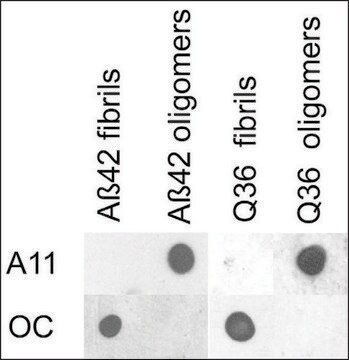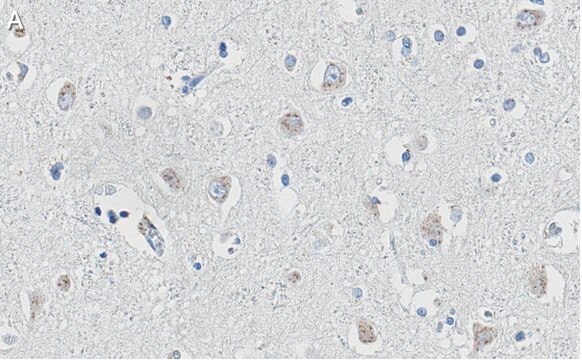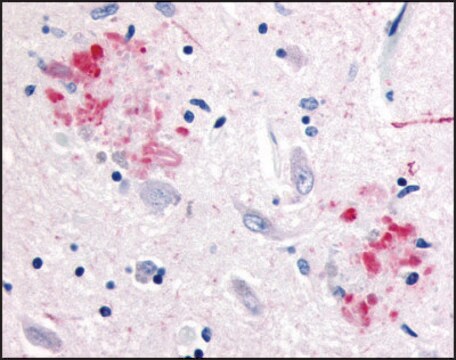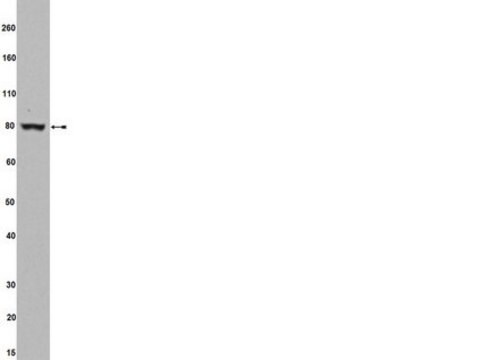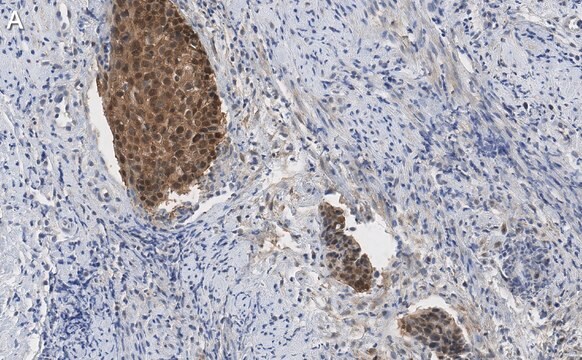추천 제품
생물학적 소스
rabbit
Quality Level
결합
unconjugated
항체 형태
IgG fraction of antiserum
항체 생산 유형
primary antibodies
클론
polyclonal
형태
buffered aqueous solution
분자량
85 kDa
종 반응성
bovine, rabbit, rat, guinea pig, horse, mouse, dog, human
농도
0.5 mg - 1 mg/mL
기술
immunohistochemistry: suitable
western blot: suitable
UniProt 수납 번호
배송 상태
wet ice
저장 온도
−20°C
타겟 번역 후 변형
unmodified
유전자 정보
human ... APP(351)
면역원
Synthetic peptide directed towards the middle region of human APP
생화학적/생리학적 작용
APP is a cell surface receptor and transmembrane precursor protein that is cleaved by secretases to form a number of peptides. Some of these peptides are secreted and can bind to the acetyltransferase complex APBB1/TIP60 to promote transcriptional activation, while others form the protein basis of the amyloid plaques found in the brains of patients with Alzheimer disease. Mutations in this gene have been implicated in autosomal dominant Alzheimer disease and cerebroarterial amyloidosis (cerebral amyloid angiopathy). Multiple transcript variants encoding several different isoforms have been found for this gene.This gene encodes a cell surface receptor and transmembrane precursor protein that is cleaved by secretases to form a number of peptides. Some of these peptides are secreted and can bind to the acetyltransferase complex APBB1/TIP60 to promote transcriptional activation, while others form the protein basis of the amyloid plaques found in the brains of patients with Alzheimer disease. Mutations in this gene have been implicated in autosomal dominant Alzheimer disease and cerebroarterial amyloidosis (cerebral amyloid angiopathy). Multiple transcript variants encoding several different isoforms have been found for this gene.
서열
Synthetic peptide located within the following region: RMNQSLSLLYNVPAVAEEIQDEVDELLQKEQNYSDDVLANMISEPRISYG
물리적 형태
Purified antibody supplied in 1x PBS buffer with 0.09% (w/v) sodium azide and 2% sucrose.
면책조항
Unless otherwise stated in our catalog or other company documentation accompanying the product(s), our products are intended for research use only and are not to be used for any other purpose, which includes but is not limited to, unauthorized commercial uses, in vitro diagnostic uses, ex vivo or in vivo therapeutic uses or any type of consumption or application to humans or animals.
적합한 제품을 찾을 수 없으신가요?
당사의 제품 선택기 도구.을(를) 시도해 보세요.
Storage Class Code
10 - Combustible liquids
WGK
WGK 3
Flash Point (°F)
Not applicable
Flash Point (°C)
Not applicable
시험 성적서(COA)
제품의 로트/배치 번호를 입력하여 시험 성적서(COA)을 검색하십시오. 로트 및 배치 번호는 제품 라벨에 있는 ‘로트’ 또는 ‘배치’라는 용어 뒤에서 찾을 수 있습니다.
Noemí Fabelo et al.
Neurobiology of aging, 35(8), 1801-1812 (2014-03-13)
The presence of lipid alterations in lipid rafts from the frontal cortex in late stages of Alzheimer's disease (AD) has been recently demonstrated. Here, we have isolated and analyzed the lipid composition of lipid rafts from different brain areas from
Xiangmei Wu et al.
Molecular neurobiology, 50(3), 839-851 (2014-04-15)
Chronic cerebral hypoperfusion is associated with cognitive decline in aging and age-related neurodegenerative disease. Epigenetic mechanisms are involved in the maintenance of long-term hypoxia-adapted cellular phenotypes. In the present study, the epigenetic signatures such as DNA methylation and histone acetylation
Yuan Zhou et al.
PloS one, 9(7), e103187-e103187 (2014-07-23)
Sporadic or late-onset Alzheimer's disease (AD) is expected to affect 50% of individuals reaching 85 years of age. The most significant genetic risk factor for late-onset AD is the e4 allele of APOE gene encoding apolipoprotein E, a lipid carrier
Kaja Plucińska et al.
The Journal of neuroscience : the official journal of the Society for Neuroscience, 34(32), 10710-10728 (2014-08-08)
Key neuropathological hallmarks of Alzheimer's disease (AD) are elevated levels of amyloid β-peptide (Aβ) species generated via amyloid precursor protein (APP) endoproteolysis and cleavage by the rate-limiting β-site enzyme 1 (BACE1). Because rodents do not develop amyloid pathologies, we here
Flaubert Tchantchou et al.
Neuropharmacology, 85, 427-439 (2014-06-18)
Traumatic brain injury (TBI) is the leading cause of death in young adults in the United States, but there is still no effective agent for treatment. N-arachidonoylethanolamine (anandamide, AEA) is a major endocannabinoid in the brain. Its increase after brain
자사의 과학자팀은 생명 과학, 재료 과학, 화학 합성, 크로마토그래피, 분석 및 기타 많은 영역을 포함한 모든 과학 분야에 경험이 있습니다..
고객지원팀으로 연락바랍니다.